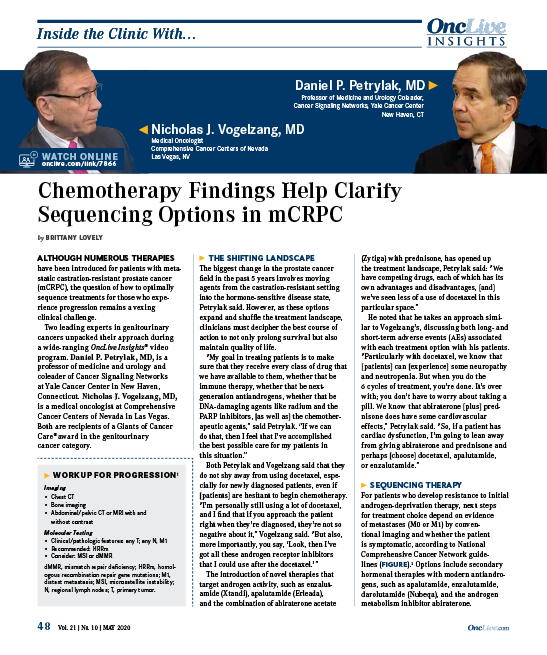Publication
Article
OncLive Insights®: Chemotherapy Findings Help Clarify Sequencing Options in mCRPC
Author(s):
Although numerous therapies have been introduced for patients with metastatic castration-resistant prostate cancer, the question of how to optimally sequence treatments for those who experience progression remains a vexing clinical challenge.
Daniel P. Petrylak, MD

Although numerous therapies have been introduced for patients with metastatic castration-resistant prostate cancer (mCRPC), the question of how to optimally sequence treatments for those who experience progression remains a vexing clinical challenge.
Two leading experts in genitourinary cancers unpacked their approach during a wide-ranging OncLive Insights® video program. Daniel P. Petrylak, MD, is a professor of medicine and urology and coleader of Cancer Signaling Networks at Yale Cancer Center in New Haven, Connecticut. Nicholas J. Vogelzang, MD, is a medical oncologist at Comprehensive Cancer Centers of Nevada in Las Vegas. Both are recipients of a Giants of Cancer Care® award in the genitourinary cancer category.
The Shifting Landscape
The biggest change in the prostate cancer field in the past 5 years involves moving agents from the castration-resistant setting into the hormone-sensitive disease state, Petrylak said. However, as these options expand and shuffle the treatment landscape, clinicians must decipher the best course of action to not only prolong survival but also maintain quality of life.
“My goal in treating patients is to make sure that they receive every class of drug that we have available to them, whether that be immune therapy, whether that be nextgeneration antiandrogens, whether that be DNA-damaging agents like radium and the PARP inhibitors, [as well as] the chemotherapeutic agents,” said Petrylak. “If we can do that, then I feel that I’ve accomplished the best possible care for my patients in this situation.”

Both Petrylak and Vogelzang said that they do not shy away from using docetaxel, especially for newly diagnosed patients, even if [patients] are hesitant to begin chemotherapy. “I’m personally still using a lot of docetaxel, and I find that if you approach the patient right when they’re diagnosed, they’re not so negative about it,” Vogelzang said. “But also, more importantly, you say, ‘Look, then I’ve got all these androgen receptor inhibitors that I could use after the docetaxel.’ ”
The introduction of novel therapies that target androgen activity, such as enzalutamide (Xtandi), apalutamide (Erleada), and the combination of abiraterone acetate (Zytiga) with prednisone, has opened up the treatment landscape, Petrylak said: “We have competing drugs, each of which has its own advantages and disadvantages, [and] we’ve seen less of a use of docetaxel in this particular space.”
He noted that he takes an approach similar to Vogelzang’s, discussing both long- and short-term adverse events (AEs) associated with each treatment option with his patients. “Particularly with docetaxel, we know that [patients] can [experience] some neuropathy and neutropenia. But when you do the 6 cycles of treatment, you’re done. It’s over with; you don’t have to worry about taking a pill. We know that abiraterone [plus] prednisone does have some cardiovascular effects,” Petrylak said. “So, if a patient has cardiac dysfunction, I’m going to lean away from giving abiraterone and prednisone and perhaps [choose] docetaxel, apalutamide, or enzalutamide.”
Sequencing Therapy
For patients who develop resistance to initial androgen-deprivation therapy, next steps for treatment choice depend on evidence of metastases (M0 or M1) by conventional imaging and whether the patient is symptomatic, according to National Comprehensive Cancer Network guidelines (Figure).1 Options include secondary hormonal therapies with modern antiandrogens, such as apalutamide, enzalutamide, darolutamide (Nubeqa), and the androgen metabolism inhibitor abiraterone.
For patients with distant metastases (M1), first-line regimens with category 1 recommendations consist of abiraterone, docetaxel, enzalutamide, and sipuleucel-T (Provenge), as well as radium-223 dichloride (Xofigo) for those with symptomatic bone metastases.1
Second-line recommendations depend on the therapies used in the first-line mCRPC setting and whether molecular testing reveals an aberration that suggests use of the PARP inhibitor olaparib (Lynparza) for patients with homologous recombination repair mutations or the anti–PD-1 inhibitor pembrolizumab (Keytruda) for those with microsatellite instability (MSI)– high tumors or mismatch repair deficiency. Docetaxel has a category 1 recommendation after first-line abiraterone or enzalutamide, whereas preferred regimens after first-line docetaxel are abiraterone, enzalutamide, or the chemotherapy cabazitaxel (Jevtana).
For patients who progress or whose prostate- specific antigen (PSA) levels rise despite androgen-targeting therapy, deciphering the best course of treatment presents a challenge. Sequencing regimens based on available data factor into approaches following front-line treatment, as do insurance hurdles.
“What I often tell the patient is, ‘Look, the cancer that we started treating you with way back when with androgen deprivation therapy and perhaps docetaxel, now after AR [androgen receptor] inhibition,…has evolved,” Vogelzang said. “The tumor is now a different tumor.”
New Role for Cabazitaxel
Petrylak noted that results from the CARD trial (NCT02485691) helped clarify some of the questions surrounding which therapy to use after progression. The findings demonstrated that cabazitaxel, a next-generation taxane already approved for mCRPC after prior docetaxel-containing therapy, is a more effective choice for subsequent therapy than continued use of agents that target androgen signaling.2
“The CARD trial was a study that looked at sequential treatments in castrate-resistant disease. Generally, we would use next-generation antiandrogens like abiraterone or enzalutamide first, then go on to docetaxel,” Petrylak said. “The question has always been ‘What’s the next step?’ A lot of people will try another next-generation agent or, of course, go on chemotherapy. And the thought was ‘Well, chemotherapy is more toxic; we don’t want to use it in this situation,’ but the CARD trial helps answer that particular question.”

The study involved 255 patients with mCRPC with castrate levels of serum testosterone (<0.5 ng/mL) whose disease had progressed after prior docetaxel and within 12 months of receiving either abiraterone or enzalutamide. Progression was defined according to RECIST criteria or by the appearance of at least 2 new bone lesions or rising PSA levels.
Patients were randomized to receive cabazitaxel (25 mg/m2 every 3 weeks) or antiandrogen therapy with either abiraterone (1000 mg once daily) plus prednisone (5 mg twice daily) or enzalutamide (160 mg once daily), depending on which agent they had previously received. Participants in the cabazitaxel arm also received oral prednisone (10 mg daily) and prophylactic granulocyte colony-stimulating factor.
After a median follow-up of 9.2 months, median imaging-based progression-free survival (PFS) was 8.0 months in the cabazitaxel arm (n = 129) and 3.7 months in the abiraterone/enzalutamide arm (n = 126), with a cabazitaxel-favoring HR of 0.54 (95% CI, 0.40-0.73; P <.001). The data also supported the efficacy of cabazitaxel in overall survival (median 13.6 vs 11.0 months; HR, 0.64; 95% CI, 0.46-0.89; P = .008).2
“[These results] lend a lot of credence to the idea that the tumor has evolved away from androgen receptor dependence to a more neuroendocrine, more chemo-responsive [tumor],” Vogelzang said.
Investigators also seek to determine whether dual chemotherapy with cabazitaxel in combination with carboplatin can address the resistance to therapies that inhibit androgen signaling in progressive mCRPC. The combination showed early signs of efficacy in a phase 1/2 trial (NCT01505868), and a randomized phase 3 study is planned.3
Another available option for clinicians is sipuleucel-T, an autologous cellular immunotherapy approved by the FDA in 2010 to treat asymptomatic or minimally symptomatic patients with mCRPC.4 Sipuleucel-T is designed to induce an immune response targeted against prostatic acid phosphatase, an antigen expressed in most prostate cancers. The agent typically is administered in 3 intravenous infusions every 2 weeks (at approximately weeks 0, 2, and 4).4
Emerging data show that sipuleucel-T may be more effective if administered earlier in the treatment timeline, according to Petrylak. “Before the PSA gets to 22 is one of the thoughts,” he said. “I think that it’s underused and underappreciated. It is a process that has activity and a proven survival benefit.”
Future of Targeted Agents
PARP inhibitors are poised to make an impact on the future of treatment for patients with refractory prostate cancer, Petrylak noted, adding that that efficacy has been seen only in small patient populations thus far. “The issue is really trying to assess [these small patient populations]. Number 1, we all have to check our patients molecularly now. This is now an absolute. You have to check them for MSI. You have to check them now for DNA repair mutations, because we can make an impact on our patient’s care by administering drugs based upon these particular markers,” he said.
Several exciting trials recently released data for using PARP inhibitors in castrate-resistant disease, Petrylak added, citing the PROfound study (NCT02987543). The phase 3 randomized trial met its primary end point of radiographic PFS.
The trial recruited 387 patients with mCRPC who had disease progression after receiving newer hormone-targeting agents and had BRCA1, BRCA2, or ATM (cohort A) alteration or 1 or more of 12 gene alterations associated with homologous recombination repair (cohort B). Patients were randomized 2:1 to receive either olaparib (300 mg twice daily) or physician’s choice of abiraterone (1000 once daily) plus prednisone (5 mg twice daily) or enzalutamide (160 mg once daily).5
The benefit of olaparib was observed regardless of previous treatment with or without taxane therapy. However, the greatest benefit was observed in cohort A, with a radiographic PFS of 7.4 months with olaparib versus 3.6 months with other hormonal agents in patients previously treated with taxane therapy (HR, 0.34; 95% CI, 0.25-0.47).5
“It’s very exciting that we’ve been able to select patients with a different molecular mutation and then administer a drug based upon that mutation,” Petrylak said. He added that approximately 20% of all patients with castration-resistant prostate cancer and 10% of all patients have BRCA1 or BRCA2 alterations.
Vogelzang posed the question “If you’re testing early on in all patients, and if you don’t find a BRCA [mutation] or a DNA repair deficiency, would you retest your patients?” Petrylak said that he does retest. “[There] could be a clonal evolution of something that may not be picked up in the original test,” he explained. “But I’m also excited about drugs that are trying to induce BRCA, and I think that this is going to be the next step in this particular pathway.…How can we induce the cell to downregulate the DNA repair pathway such that you are sensitive to a PARP inhibitor?”
Maintaining Quality of Life
Petrylak emphasized the importance of open communication between patient and physician, especially with regard to expected and reported AEs, throughout the treatment process for mCRPC. “If we catch a fever early, if we catch fatigue early, we may be able to do some things to fix those, so that the patient can tolerate chemotherapy better,” he said. Overcoming patient fear and aversion to chemotherapy goes hand in hand with maintaining open communication.
Karim Fizazi, MD, PhD, and collegues presented quality-of-life results from the CARD trial at the 2020 American Society of Clinical Oncology Genitourinary Cancers Symposium.6 The analysis evaluated changes in pain and health-related quality of life with the primary end points of pain response and time to pain progression, symptomatic skeletal events, and patientreported outcomes.
The pain response, defined as a decrease of 30% or more from baseline in Brief Pain Inventory–Short Form pain intensity score, was 45.0% in the cabazitaxel arm (n = 111) versus 19.3% in the enzalutamide/ abiraterone arm (n = 109; P <.0001). The percentage of patients with the probability of not having pain progression after 12 months was 66.2% versus 45.3%, respectively. The median time to first symptomatic skeletal events was not reached (NR) in the cabazitaxel arm (95% CI, 20.0-NR) versus 16.7 months (95% CI, 10.8-NR) in the enzalutamide/abiraterone arm (HR, 0.59; 95% CI, 0.35-1.01; P = .05).5 Changes in quality-of-life domains measured through the Functional Assessment of Cancer Therapy–Prostate questionnaire also favored cabazitaxel.6
The authors concluded that use of cabazitaxel should be considered over a second androgen-signaling–targeted inhibitor in patients who have progression within 12 months following treatment with docetaxel and another inhibitor aimed at androgen signaling. Petrylak noted that quality-of-life data did not show much of a difference between the study drugs. “That tells us that the activity of the drugs may actually be helping overcome some of the adverse effects,” Petrylak said, adding that fatigue is an AE that needs to be monitored “very, very carefully” in patients receiving enzalutamide.
References
- National Comprehensive Cancer Network. Clinical Practice Guidelines in Oncology. Prostate Cancer (version 1.2020). Updated March 16, 2020. Accessed April 27, 2020. https://www.nccn.org/professionals/physician_ gls/pdf/prostate.pdf
- de Wit R, de Bono J, Sternberg CN, et al; CARD Investigators. Cabazitaxel versus abiraterone or enzalutamide in metastatic prostate cancer. N Engl J Med. 2019;381(26):2506-2518. doi:10.1056/NEJMoa1911206
- Corn PG, Heath EI, Zurita A, et al. Cabazitaxel plus carboplatin for the treatment of men with metastatic castration-resistant prostate cancers: a randomised, open-label, phase 1-2 trial. Lancet Oncol. 2019;20(10):1432-1443. doi:10.1016/ S1470-2045(19)30408-5. Published correction appears in Lancet Oncol. 2020:21(1):e14. doi:10.1016/S1470- 2045(19)30754-5
- Provenge (sipuleucel-T). FDA. Updated May 28, 2019. Accessed April 27, 2020. https://www.fda.gov/vaccines- blood-biologics/cellular-gene-therapy-products/ provenge-sipuleucel-t
- De Bono JS, Mateo K, Fizazi K, et al. Olaparib for metastatic castration-resistant prostate cancer. Published online April 28, 2020. N Engl J Med. doi:10.1056/NEJMoa1911440
- Fizazi K, Kramer G, Eymard JC, et al. Pain response and health-related quality of life (HRQL) in patients with metastatic castration-resistant prostate cancer (mCRPC) receiving cabazitaxel (CBZ) versus abiraterone or enzalutamide in the CARD study. Presented at: 2020 American Society of Clinical Oncology Genitourinary Cancers Symposium; February 13- 15, 2020; San Francisco, CA. Abstract 16. https://meetinglibrary. asco.org/record/184110/poster
Click here to download the PDF:











